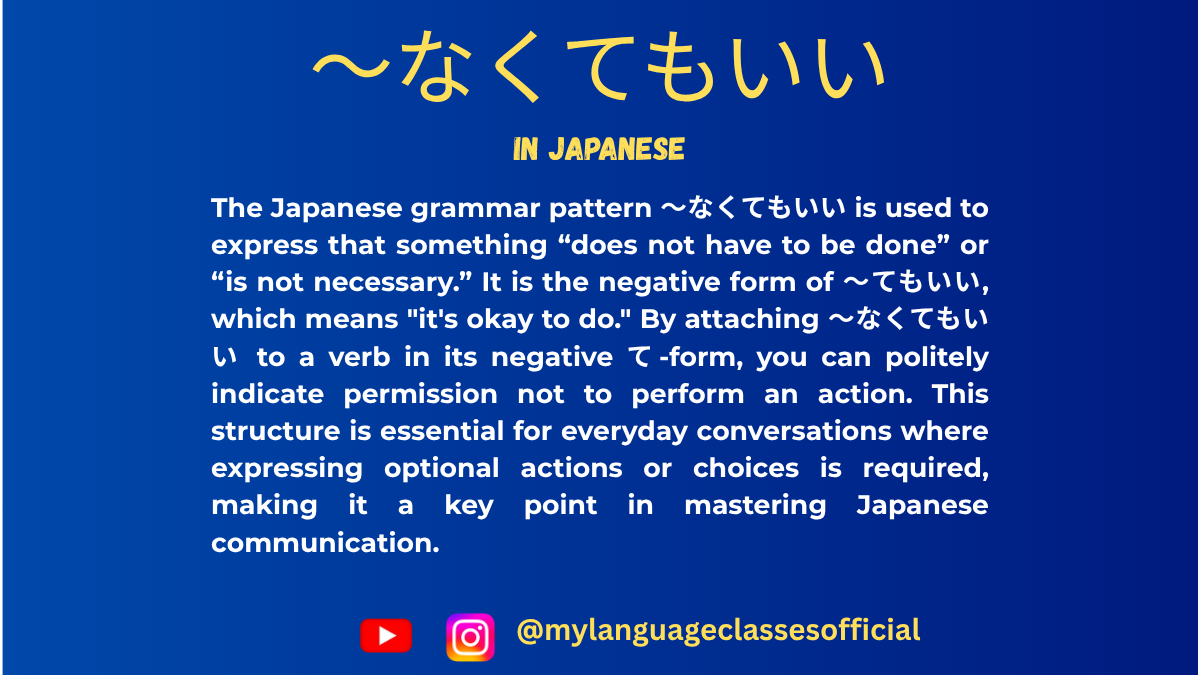Your cart is currently empty!
Tag: learning Japanese grammar
-

How to Use 〜てもらう | My Language Classes
The Japanese Grammar 〜てもらう
The Japanese grammar pattern 〜てもらう is an essential structure used to express receiving a favor from someone. It emphasizes that someone is doing something beneficial for the speaker or a third party. Understanding this grammar is crucial for natural and polite Japanese communication.
This post will explain 〜てもらう in various situations, provide example sentences, and list common contexts where it is used.
Structure of 〜てもらう
The pattern follows this structure:
Person A (receiver) + は/が + Person B (doer) + に + Verb in 〜て form + もらう
- A is the person who benefits from the action.
- B is the person performing the action for A.
- The verb is conjugated into the て-form and followed by もらう (to receive).
Example:
- 私は先生に日本語を教えてもらいました。
(I had my teacher teach me Japanese.)
Difference Between 〜てもらう and 〜てあげる
- 〜てもらう: Focuses on the receiver of the favor.
- 〜てあげる: Focuses on the giver of the favor.
Example:
- 私は先生に日本語を教えてもらいました。 (I received Japanese lessons from my teacher.)
- 私は先生に日本語を教えてあげました。 (I taught Japanese to my teacher.)
Various Situations Where 〜てもらう Is Used
1. Receiving Help
When someone helps you with a task or does something for your benefit.
Example:
- 私は彼氏に財実を送ってもらいました。
(I had my boyfriend send my wallet.)
2. Receiving Permission
Used when asking for permission to do something.
Example:
- 先生にはやく帰らせてもらいました。
(I got permission from my teacher to leave early.)
3. Receiving a Favor Indirectly
You receive a favor, but a third party performs the action.
Example:
- 母は先生にむすこの学校の事を説明してもらいました。
(My mother had the teacher explain about the school to her.)
4. Making Polite Requests
When requesting someone to do something politely.
Example:
- この文章を正しく直してもらえますか。
(Could you please correct this text for me?)
5. Receiving Information
When someone shares knowledge or guidance.
Example:
- 先生にいろいろな情報を教えてもらいました。
(I received a lot of information from my teacher.)
6. Asking for Medical Assistance
Used when getting treatment or medical help from someone.
Example:
- 医者に病治をしてもらいました。
(I got treated by the doctor.)
7. Receiving a Physical Object
Used when someone gives you something.
Example:
- 友人に好きな本を買ってもらいました。
(My friend bought me a book I like.)
8. Receiving Guidance or Instructions
Used when someone teaches you or gives instructions.
Example:
- 先生に作文の書き方を教えてもらいました。
(I had my teacher teach me how to write essays.)
Summary of Situations Where 〜てもらう Is Used
Here’s a quick reference list:
- Receiving help (task-related support)
- Receiving permission
- Receiving a favor indirectly
- Making polite requests
- Receiving information or knowledge
- Asking for medical assistance
- Receiving a physical object
- Receiving guidance or instructions
Conclusion
〜てもらう is a crucial grammar point in Japanese, allowing you to express receiving favors, help, or benefits from others. Mastering this structure enhances your ability to communicate politely and effectively in various situations. Practice using it in conversations to improve fluency and comprehension!
If you enjoyed this lesson, be sure to check out more posts like this on my blog at My Language Classes. Don’t forget to subscribe my YouTube channel and follow me on Instagram for the latest language learning tips and lessons. Leave a comment below to share your thoughts, or ask any questions you have about nouns.
Happy learning! 😊
-
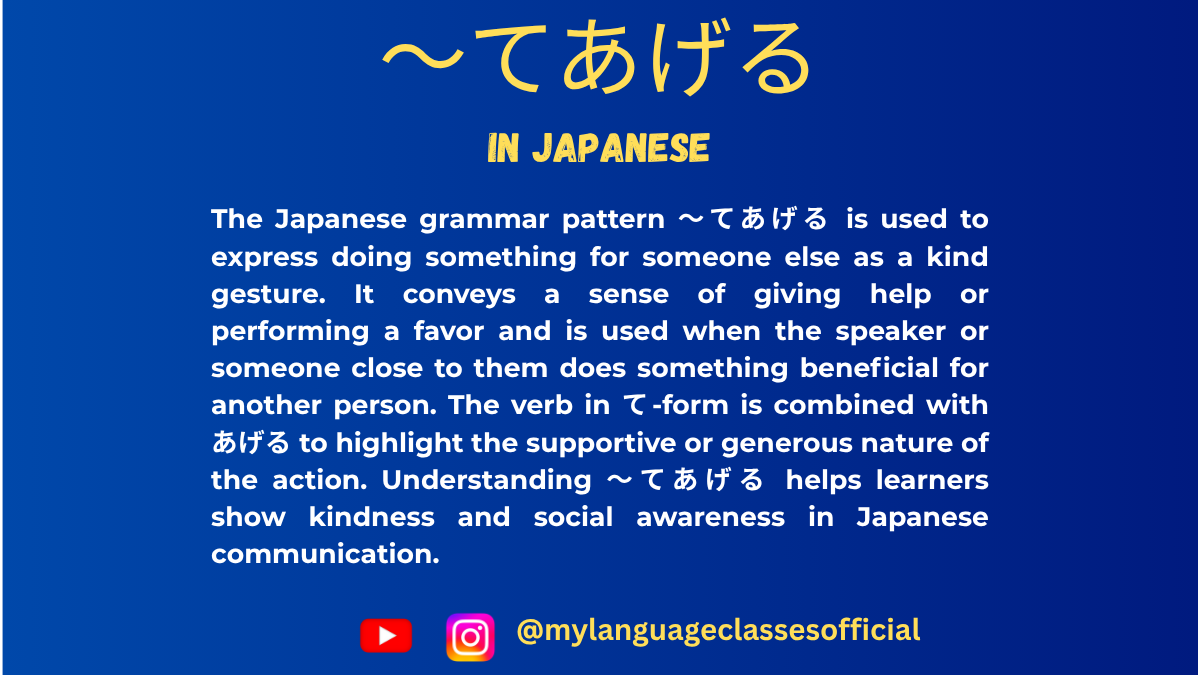
How to Use 〜てあげる | My Language Classes
〜てあげる: To Give (an Action) in Japanese
When learning Japanese, you will often encounter the phrase 〜てあげる (te ageru), which means “to give (an action).” This phrase is used when the speaker or someone performs a beneficial action for another person. The nuance of 〜てあげる is that the action is done out of kindness or generosity.
How to Use 〜てあげる
The structure is simple:
[Person] は [Recipient] に [Action in 〜て-form] + あげる
Example:
- わたしは ともだち に 本を 貸してあげました。
(Watashi wa tomodachi ni hon o kashite agemashita.)
→ I lent a book to my friend (as a favor).
Different Forms of 〜てあげる
The verb あげる can be conjugated into different forms to match the politeness level:
Form Usage 〜てあげる Casual/plain form 〜てあげます Polite form 〜てあげて Te-form for requests 〜てあげない Negative form (not doing the action) 〜てあげなかった Past negative form Situations Where 〜てあげる Is Used
1. Doing Something Nice for Someone Else
- わたしは ちょうとせんせい に にもつを 持ってあげました。
(Watashi wa chouto sensei ni nimotsu o motte agemashita.)
→ I carried the teacher’s luggage for them.
2. Helping Someone
- おとうさんは ぼくに 自転車の修理を してあげた。
(Otousan wa boku ni jitensha no shuuri o shite ageta.)
→ Dad fixed my bicycle for me.
3. Giving Advice or Instruction
- わたしは ともだち に 日本語 を 教えてあげる。
(Watashi wa tomodachi ni nihongo o oshiete ageru.)
→ I will teach my friend Japanese.
4. Buying Something for Someone
- おかあさんは いもうと に 花を 買ってあげました。
(Okaasan wa imouto ni hana o katte agemashita.)
→ Mom bought flowers for my little sister.
5. Making a Favorable Gesture
- 私は 友達 に コーヒーを 作ってあげました。
(Watashi wa tomodachi ni koohii o tsukutte agemashita.)
→ I made coffee for my friend.
6. Expressing Kindness in a Relationship
- けんたろうは かのじょに マッサージを かいてあげた。
(Kentaro wa kanojo ni massaaji o kaite ageta.)
→ Kentaro gave his girlfriend a massage.
7. Helping Children or Animals
- おねえさんは 犬 に 食べ物 を あげてあげた。
(Oneesan wa inu ni tabemono o agete ageta.)
→ The older sister gave food to the dog.
Things to Remember About 〜てあげる
- Used when the action is beneficial: You should only use 〜てあげる when the action is helpful or kind.
- Do not use for superiors: Avoid using 〜てあげる when speaking about actions for a superior (e.g., boss, teacher) as it may sound rude. Instead, use 〜てさしあげる.
- Casual tone: This phrase is often used in informal or everyday conversations rather than in formal writing.
Summary Table: When to Use 〜てあげる
Situation Example Helping a friend はさみを 買ってあげた。 (Bought scissors for them.) Teaching someone えいご を 教えてあげる。 (Teach English to them.) Doing a favor 部屋を 掃除してあげる。 (Clean the room for them.) Helping animals 犬 に 飯 を あげてあげる。 (Give food to a dog.) By mastering 〜てあげる, you can express kindness and generosity in Japanese naturally! Practice using it in real conversations to make your speech sound more fluent and native-like.
Do you have any questions about 〜てあげる? Let me know in the comments!
If you enjoyed this lesson, be sure to check out more posts like this on my blog at My Language Classes. Don’t forget to subscribe my YouTube channel and follow me on Instagram for the latest language learning tips and lessons. Leave a comment below to share your thoughts, or ask any questions you have about nouns.
Happy learning! 😊
- わたしは ともだち に 本を 貸してあげました。
-
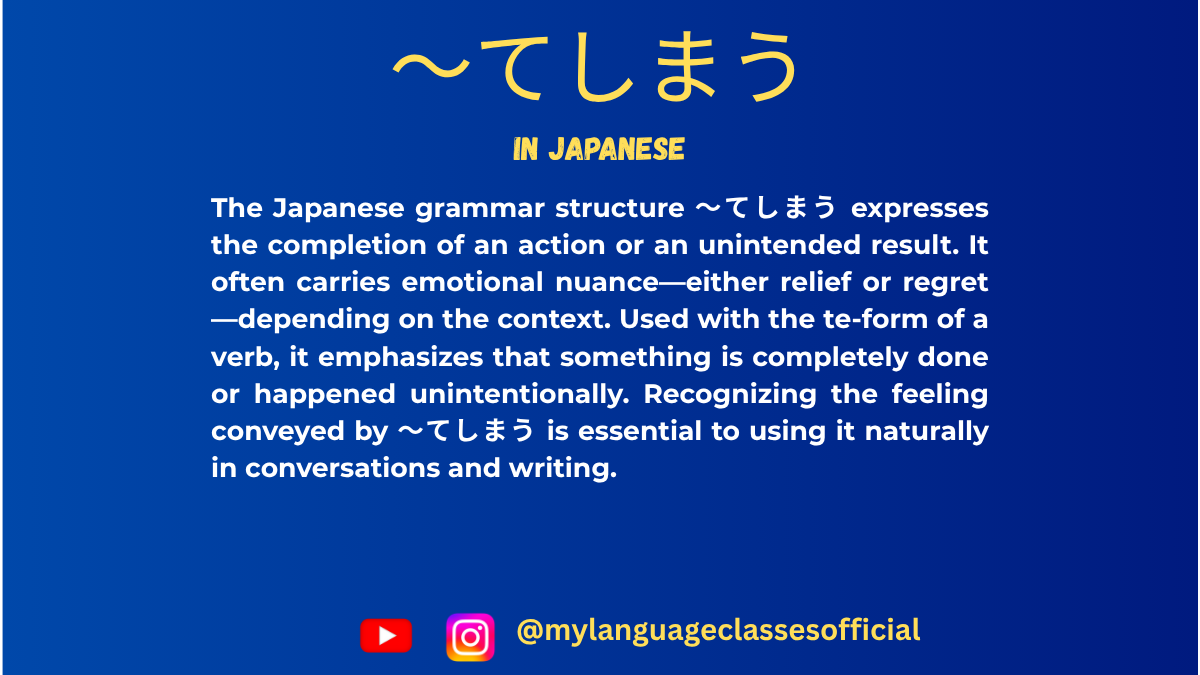
Expressing Completion or Regret in Japanese:〜てしまう| My Language Classes
Using 〜てしまう in Japanese
In Japanese, the grammar structure 〜てしまう plays a significant role in expressing either the completion of an action or a sense of regret, often depending on the context. This nuanced construction can elevate your Japanese proficiency, helping you convey subtle emotions and intentions effectively.
Let’s delve into its usage, nuances, and common situations where it applies.
What is 〜てしまう?
The form 〜てしまう is derived by attaching しまう to the て-form of a verb. The meaning can vary based on context, and it is commonly shortened in casual speech to 〜ちゃう or 〜じゃう.
- Completion: Indicates that an action has been entirely or thoroughly completed.
- Regret/Unintended Outcome: Expresses a sense of regret, disappointment, or that something happened unintentionally.
How to Form 〜てしまう
- Take the て-form of the verb.
- Example: 飲む (to drink) → 飲んで
- Add しまう.
- 飲んでしまう (to finish drinking or drink unintentionally)
Casual Contractions:
- 〜てしまう → 〜ちゃう
- 飲んでしまう → 飲んじゃう
- 〜でしまう → 〜じゃう
- 食べてしまう → 食べちゃう
Situations Where 〜てしまう is Used
- Expressing Completion of an Action
- Used to indicate that an action is finished, often with a sense of thoroughness or finality.
- Example:
- 宿題を全部やってしまいました。 (I finished all my homework.)
- ケーキを食べてしまった。 (I ate the entire cake.)
- Expressing Regret or an Unintended Outcome
- When an action leads to an unintended or regrettable result.
- Example:
- 大事な書類をなくしてしまった。 (I lost an important document.)
- 電車に傘を忘れてしまいました。 (I accidentally left my umbrella on the train.)
- Expressing Uncontrollable Situations
- Used to convey situations beyond the speaker’s control.
- Example:
- 窓が風で閉まってしまった。 (The window shut because of the wind.)
- Expressing Emotional Impact
- Can emphasize feelings of surprise, disappointment, or unintended consequences.
- Example:
- こんなに早く雨が降ってしまうなんて思わなかった。 (I didn’t think it would start raining so soon.)
- Hypothetical or Future Concerns
- Used when imagining an unintended or regretful scenario in the future.
- Example:
- テストで間違えてしまうかもしれない。 (I might make a mistake on the test.)
Key Points to Remember
- Context is Crucial:
- Depending on the situation, 〜てしまう can mean either “to finish” or “to regret.” The tone, verb, and surrounding context clarify its intended meaning.
- Shortened Forms are Common:
- In casual conversation, the contracted forms ちゃう and じゃう are more commonly used.
- Polite vs. Casual Speech:
- Formal: 書いてしまいました。 (I finished writing.)
- Casual: 書いちゃった。 (I finished writing.)
- Adding Emotional Nuance:
- Using 〜てしまう adds depth to your expression, allowing you to highlight feelings of regret, completion, or an unexpected event.
Examples of Common Scenarios
Situation Example Sentence Translation Accidental Action コーヒーをこぼしてしまいました。 (I accidentally spilled the coffee.) Forgot Something 鍵を家に忘れてしまった。 (I left my keys at home.) Regretful Action 寝坊してしまった。 (I overslept.) Uncontrollable Event 雨が降ってしまった。 (It started raining.) Complete Action 本を全部読んでしまいました。 (I finished reading the entire book.) Hypothetical Concern 試験に遅れてしまうかもしれない。 (I might be late for the exam.)
Why Use 〜てしまう?
- Adds Emotional Depth:
- Helps convey your feelings of regret, surprise, or relief.
- Expresses Finality:
- Perfect for emphasizing the completion of an action.
- Natural and Fluent Japanese:
- Using 〜てしまう naturally in conversation makes your Japanese sound more native-like.
Practice Tip: Try incorporating 〜てしまう in daily life scenarios or journaling your day in Japanese. Write about actions you completed, unintended events, or things you regretted doing.
Example Practice Sentence:
- 昨日、友達に秘密を言ってしまいました。 (Yesterday, I accidentally told my friend a secret.)
By mastering 〜てしまう, you’ll enhance your ability to express subtle emotions and actions naturally, making your Japanese more dynamic and expressive.
If you enjoyed this lesson, be sure to check out more posts like this on my blog at My Language Classes. Don’t forget to subscribe my YouTube channel and follow me on Instagram for the latest language learning tips and lessons. Leave a comment below to share your thoughts, or ask any questions you have about nouns.
Happy learning! 😊
-
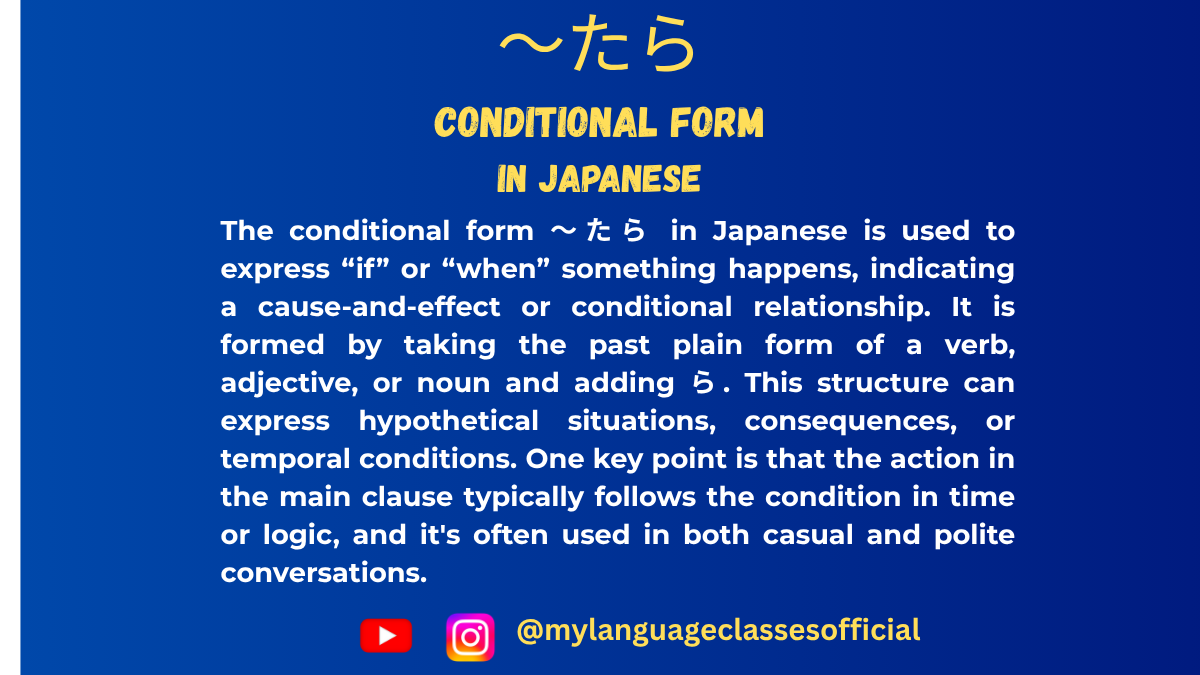
Understanding Conditional form ~たら in Japanese | My Language Classes
Understanding ~たら in Japanese
Learning Japanese grammar often feels like solving a puzzle, where each piece contributes to your fluency. One such critical piece is the ~たら structure, a conditional form that translates roughly to “if” or “when” in English. In this blog post, we’ll break down how to use ~たら effectively, covering its structure, usage, and nuances, along with examples to boost your confidence.
What is ~たら?
The ~たら structure comes from the past tense form of a verb, adjective, or noun, combined with ら (ra). It’s used to express conditional situations, which means it helps us talk about “if” or “when” something happens.
Key Functions of ~たら:
- Expressing Conditions: “If X happens, then Y will occur.”
- Temporal Sense: “When X happens, Y will follow.”
This dual meaning is a hallmark of ~たら, and context determines whether it means “if” or “when.”
The Structure of ~たら
Let’s look at how to form ~たら for different word types:
1. Verbs
- Take the plain past tense form (た-form) of the verb + ら.
- Example:
食べる → 食べた → 食べたら (if/when [I] eat)
2. Adjectives
- For い-adjectives, replace the final い with かったら.
- Example: 高い → 高かった → 高かったら (if/when [it’s] expensive)
- For な-adjectives, use the structure: adjective + だったら.
- Example: 静か → 静かだったら (if/when [it’s] quiet)
3. Nouns
- Combine the noun with だったら.
- Example: 休み → 休みだったら (if/when [it’s] a holiday)
Usage Examples
Let’s explore ~たら in action, both as “if” and “when.”
1. Conditional “If”
- 日本に行ったら、寿司を食べたいです。
(Nihon ni ittara, sushi o tabetai desu.)
If I go to Japan, I want to eat sushi. - 時間があったら、映画を見ましょう。
(Jikan ga attara, eiga o mimashou.)
If we have time, let’s watch a movie.
Here, the meaning hinges on a hypothetical condition being met.
2. Temporal “When”
- 家に帰ったら、宿題をします。
(Ie ni kaettara, shukudai o shimasu.)
When I get home, I’ll do my homework. - 雨がやんだら、公園で遊びましょう。
(Ame ga yandara, kouen de asobimashou.)
When the rain stops, let’s play at the park.
In these examples, ~たら conveys a temporal relationship, emphasizing a sequence of events.
Nuances and Tips
- Avoid Overlapping ~たら with ~と or ~ば
While ~と and ~ば also express conditions, ~たら is more versatile because it handles both “if” and “when.” However, ~と is more deterministic (e.g., water boils when heated), and ~ば can feel more formal or speculative. - Expressing Surprise or Discovery
~たら is also used to convey unexpected results:- ドアを開けたら、猫がいました。
(Doa o aketara, neko ga imashita.)
When I opened the door, there was a cat.
Here, the speaker did not anticipate finding a cat.
- ドアを開けたら、猫がいました。
- Avoid Using ~たら for Certainties
If an event is guaranteed to occur (e.g., the sun rising), use a temporal marker like ~時 instead of ~たら.
Practice Time!
Try making your own sentences using ~たら. Here are some prompts to get you started:
- What would you do if you won the lottery?
宝くじに当たったら、______。 - What will you do when the weekend comes?
週末になったら、______。
Share your answers in the comments or with your language partner. Practice makes perfect!
Final Thoughts
The ~たら structure is a cornerstone of Japanese conditional grammar. By mastering it, you’ll unlock the ability to express complex ideas about possibilities and sequences. Remember to pay attention to context to distinguish between “if” and “when,” and don’t hesitate to experiment with it in your conversations.
Ready to elevate your Japanese skills? Try using ~たら today!
If you enjoyed this lesson, be sure to check out more posts like this on my blog at My Language Classes. Don’t forget to subscribe my YouTube channel and follow me on Instagram for the latest language learning tips and lessons. Leave a comment below to share your thoughts, or ask any questions you have about nouns.
Happy learning! 😊
-
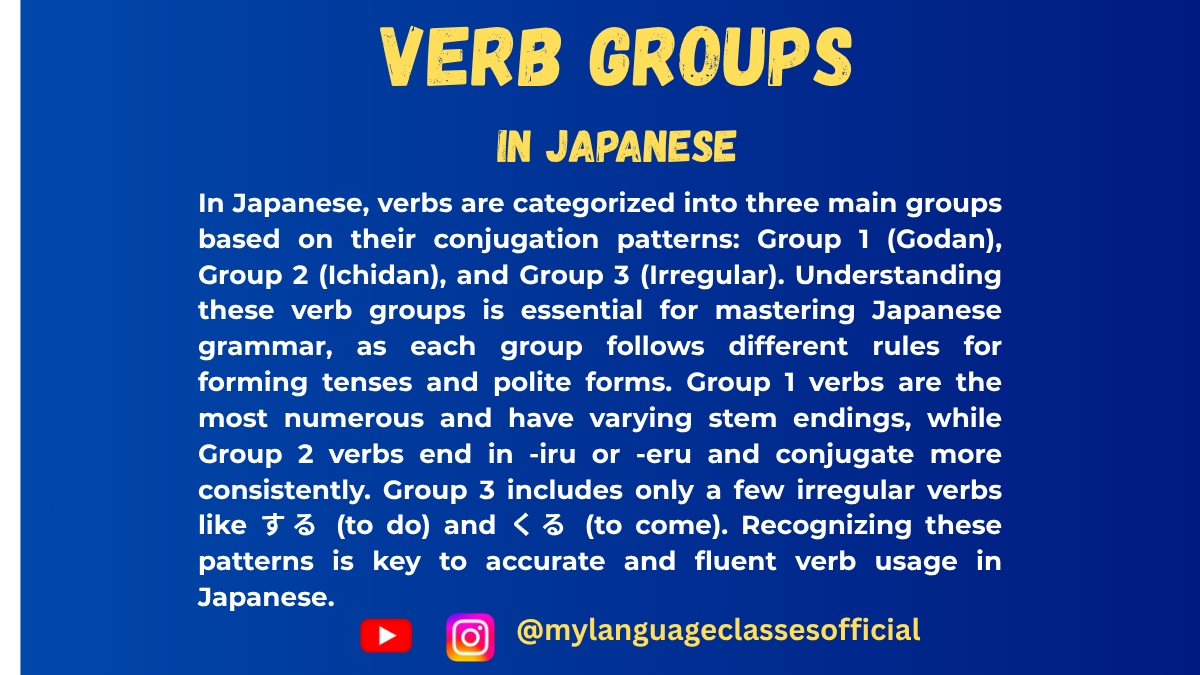
Understanding Verb Groups in Japanese | My Language Classes
Understanding Japanese Verb Groups: A Beginner’s Guide
Learning how to categorize Japanese verbs is one of the first steps to mastering the language. Verbs are divided into three groups based on their conjugation patterns, making their usage systematic. Let’s explore these three groups—Godan verbs (Group 1), Ichidan verbs (Group 2), and Irregular verbs, with examples and exceptions.
Group 1: Godan Verbs (五段動詞, Godan-doushi)
Definition:
Godan verbs are named for their stem’s ability to “move” through five vowel sounds (あ, い, う, え, お) during conjugation. They always end with a consonant + “u” in their dictionary form.Examples:
- 話す (hanasu) – to speak
- 飲む (nomu) – to drink
- 書く (kaku) – to write
- 待つ (matsu) – to wait
Conjugation Pattern:
- Dictionary Form: 飲む (nomu) – to drink
- Masu Form: 飲みます (nomimasu) – polite
- Negative Form (Casual): 飲まない (nomanai)
- Negative Form (Polite): 飲みません (nomimasen)
Exceptions in Group 1:
Some verbs appear to belong to Ichidan because they end with “iru” or “eru,” but they are actually Godan verbs. These include:- 帰る (kaeru) – to return
- 入る (hairu) – to enter
- 走る (hashiru) – to run
Be cautious with such verbs to avoid misclassification.
Group 2: Ichidan Verbs (一段動詞, Ichidan-doushi)
Definition:
Ichidan verbs are simpler to conjugate than Godan verbs because their stems remain unchanged during conjugation. They typically end with “iru” or “eru.”Examples:
- 食べる (taberu) – to eat
- 見る (miru) – to see
- 起きる (okiru) – to wake up
- 教える (oshieru) – to teach
Conjugation Pattern:
- Dictionary Form: 食べる (taberu) – to eat
- Masu Form: 食べます (tabemasu) – polite
- Negative Form (Casual): 食べない (tabenai)
- Negative Form (Polite): 食べません (tabemasen)
Exceptions in Group 2:
Most verbs ending in “iru” or “eru” are Ichidan, but some belong to Group 1 (Godan verbs). Examples include 帰る, 入る, and 走る. Be careful not to assume all “iru/eru” verbs are Ichidan.
Group 3: Irregular Verbs (不規則動詞, Fukisoku-doushi)
Definition:
There are only two irregular verbs in Japanese, and they do not follow the rules of Godan or Ichidan verbs. They are essential for daily communication, so mastering them early is a must.1. する (suru) – to do
- Dictionary Form: する (suru)
- Masu Form: します (shimasu)
- Negative Form (Casual): しない (shinai)
- Negative Form (Polite): しません (shimasen)
Usage Example:
- 宿題をする。(Shukudai o suru.) – I will do homework.
- スポーツをします。(Supootsu o shimasu.) – I will play sports.
2. 来る (kuru) – to come
- Dictionary Form: 来る (kuru)
- Masu Form: 来ます (kimasu)
- Negative Form (Casual): 来ない (konai)
- Negative Form (Polite): 来ません (kimasen)
Usage Example:
- 友達が来る。(Tomodachi ga kuru.) – My friend will come.
- 明日来ます。(Ashita kimasu.) – I will come tomorrow.
Summary Table
Group Ending Examples Key Exceptions Group 1 (Godan) Consonant + “u” 話す, 飲む, 書く, 待つ 帰る, 入る, 走る Group 2 (Ichidan) “iru” or “eru” 食べる, 見る, 起きる N/A (except those in Godan) Group 3 (Irregular) N/A する, 来る None
Tips for Remembering Verb Groups
- Practice Conjugation: Repeat conjugation patterns until they become second nature.
- Watch for Exceptions: Memorize verbs like 帰る and 入る, which may trick beginners.
- Learn Common Irregular Verbs: Start with する and 来る since they are widely used.
Understanding and categorizing Japanese verbs correctly is the first step to fluency. With consistent practice, you’ll soon find it easier to conjugate and use these verbs in conversation.
がんばってね! (Ganbatte ne!) – Good luck!
If you enjoyed this lesson, be sure to check out more posts like this on my blog at My Language Classes. Don’t forget to subscribe my YouTube channel and follow me on Instagram for the latest language learning tips and lessons. Leave a comment below to share your thoughts, or ask any questions you have about nouns.
Happy learning! 😊

